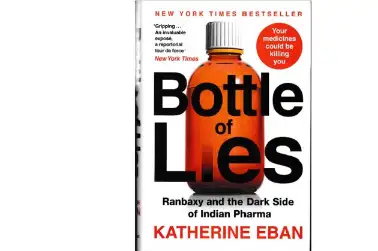BY VISHNU MAKHIJANI
New Delhi, American investigative journalist Katherine Eban pored over roughly 20,000 internal documents from the US FDA, including emails, memorandums, minutes of meetings and thousands of internal government records, as also replies under the Freedom of Information Act, to piece together a riveting and definitive account of how once storied Indian pharma major Ranbaxy blatantly cut corners – to improve its bottom line.
"I discovered that a cloud hovered over the company. American regulators were investigating whether Ranbaxy had fabricated quality data in order to gain approval to market its drugs. The allegations had first been made by a company whistleblower who had contacted the agency (FDA)," Eban, who travelled halfway across the globe as part of her investigations, writes in "Bottle of Lies – Ranbaxy and the Dark Side of Indian Pharma" (Juggernaut/pp 482/Rs 699).
The whistleblower in question, says Eban, is Dinesh Thakur, then Ranbaxy's Director and Global Head of Research, Information and Portfolio Management, who, in 2004, put together a team to study a deadly secret he had come across: that the company was fudging data.
"Little by little, as the team members stitched together small bits of information, they stumbled into Ranbaxy's secret: the company manupulated almost every aspect of its manufacturing process to quickly produce impressive looking data that would bolster its bottom line," Eban writes.
"Each member of Thakur's team came back with similar examples. At the behest of managers, the company's scientists substituted lower-purity ingredients for higher ones to reduce costs. They altered test parameters so that formulations with higher impurities could be approved. They faked dissolution studies. To generate optimal results, they crushed up brand-name drugs into capsules so that they could be tested in lieu of the company's own drugs. They superimposed brand-name test results onto their own in applications," the book says.
Noting that document forgery "was pervasive", the book says: "The company even forged its own standard operating procedures, which FDA investigators rely on to assess whether a company is following its own policies. In one instance, employees backdated documents and then artificially aged them in a steamy room overnight in an attempt to fool regulators during inspections", the book says.
Essentially, Ranbaxy's manufacturing standards "boiled down to whatever the company could get away with", the book says.
Thakur worked 14-hour days and after weeks of exhaustive research, brought his team's preliminary findings to his boss, Raj Kumar.
"Once Kumar heard from each member of Thakur's team, it finally sank in. The company was committing fraud and potentially harming patients on a global scale. He distilled the information into a four-page report for the CEO, Brian Tempest," that "laid bare systematic fraud in Ranbaxy's worldwide regulatory filings", the book says.
Predictably, there was no action as the findings "were not news to Ranbaxy's top executives", Eban writes in the book , and when Thakur pressed the issue, the company fought back in a rather unusual manner: It accused him of downloading pornography on his office computer.
Thakur realised he had to go but agonised on what to do next. He made his first move, masking his identity, on the morning of August 15, 2005 but when there was no action for two weeks, he sent a message directly to FDA Commissioner Lester Crawford, the book says. The result was immediate and set in motion a chain of events that culminated in May 2013 with Ranbaxy pleading guilty to felony charges in the manufacture and distribution of certain adulterated drugs made at two of its facilities in India, and misrepresenting clinical generic drug data.
"In the largest drug safety settlement to date with a generic drug manufacturer… Ranbaxy also agreed to pay a criminal fine and forfeiture totaling $150 million and to settle civil claims under the False Claims Act and related State laws for $350 million," the Justice Department said in a statement on May 13, 2013.
Ranbaxy also pleaded guilty to three felony FDCA (Food Drug and Cosmetic Act) counts, and four felony counts of knowingly making material false statements to the FDA. Among the adulterated products were antiretroviral (ARV) drugs destined for treatment of HIV/AIDS in Africa.
In this context, the book notes that the endorsement in November 2013 of Ranbaxy and other Indian pharma companies by former US President Bill Clinton for their efforts at producing low-cost generics had set the sales of the ARV drugs zooming.
In the midst of all this, Ranbaxy initially passed into the hands of Japan's Daiichi-Sankyo in November 2008 and was bought over in April 2014 by India's Sun Pharmaceutical.
In February, the Supreme Court asked the company's former owners, Malvinder Mohan Singh and his brother Shivinder to cough up the Rs 35 billion they owe to Daiichi Sankyo in compensation post its exit from the company – warning they could be jailed if they failed to do so.




























